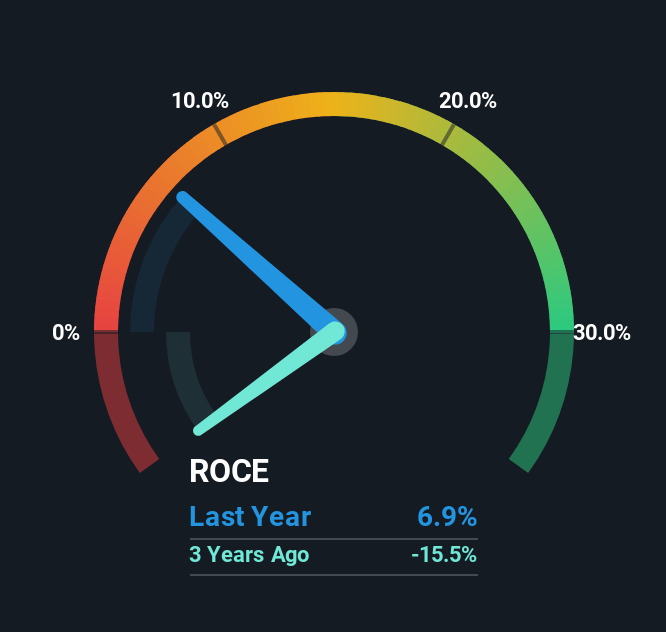Returns On Capital Are Showing Encouraging Signs At Structural Monitoring Systems (ASX:SMN)
There are a few key trends to look for if we want to identify the next multi-bagger. Ideally, a business will show two trends; firstly a growing return on capital employed (ROCE) and secondly, an increasing amount of capital employed. Put simply, these types of businesses are compounding machines, meaning they are continually reinvesting their earnings at ever-higher rates of return. So when we looked at Structural Monitoring Systems (ASX:SMN) and its trend of ROCE, we really liked what we saw.
Understanding Return On Capital Employed (ROCE)
For those that aren't sure what ROCE is, it measures the amount of pre-tax profits a company can generate from the capital employed in its business. Analysts use this formula to calculate it for Structural Monitoring Systems:
Return on Capital Employed = Earnings Before Interest and Tax (EBIT) ÷ (Total Assets - Current Liabilities)
0.069 = AU$2.1m ÷ (AU$35m - AU$4.9m) (Based on the trailing twelve months to June 2025).
So, Structural Monitoring Systems has an ROCE of 6.9%. Ultimately, that's a low return and it under-performs the Electronic industry average of 9.4%.
Check out our latest analysis for Structural Monitoring Systems

While the past is not representative of the future, it can be helpful to know how a company has performed historically, which is why we have this chart above. If you're interested in investigating Structural Monitoring Systems' past further, check out this free graph covering Structural Monitoring Systems' past earnings, revenue and cash flow.
What Does the ROCE Trend For Structural Monitoring Systems Tell Us?
The fact that Structural Monitoring Systems is now generating some pre-tax profits from its prior investments is very encouraging. The company was generating losses five years ago, but now it's earning 6.9% which is a sight for sore eyes. And unsurprisingly, like most companies trying to break into the black, Structural Monitoring Systems is utilizing 115% more capital than it was five years ago. We like this trend, because it tells us the company has profitable reinvestment opportunities available to it, and if it continues going forward that can lead to a multi-bagger performance.
What We Can Learn From Structural Monitoring Systems' ROCE
To the delight of most shareholders, Structural Monitoring Systems has now broken into profitability. Since the stock has only returned 3.3% to shareholders over the last five years, the promising fundamentals may not be recognized yet by investors. So exploring more about this stock could uncover a good opportunity, if the valuation and other metrics stack up.
Like most companies, Structural Monitoring Systems does come with some risks, and we've found 2 warning signs that you should be aware of.
While Structural Monitoring Systems may not currently earn the highest returns, we've compiled a list of companies that currently earn more than 25% return on equity. Check out this free list here.
New: Manage All Your Stock Portfolios in One Place
We've created the ultimate portfolio companion for stock investors, and it's free.
• Connect an unlimited number of Portfolios and see your total in one currency
• Be alerted to new Warning Signs or Risks via email or mobile
• Track the Fair Value of your stocks
Have feedback on this article? Concerned about the content? Get in touch with us directly. Alternatively, email editorial-team (at) simplywallst.com.
This article by Simply Wall St is general in nature. We provide commentary based on historical data and analyst forecasts only using an unbiased methodology and our articles are not intended to be financial advice. It does not constitute a recommendation to buy or sell any stock, and does not take account of your objectives, or your financial situation. We aim to bring you long-term focused analysis driven by fundamental data. Note that our analysis may not factor in the latest price-sensitive company announcements or qualitative material. Simply Wall St has no position in any stocks mentioned.
About ASX:SMN
Structural Monitoring Systems
Engages in the design, development, and manufacture of avionic products in the Americas, Europe, the United Kingdom, Asia, Middle East, Australasia, and Africa.
Excellent balance sheet with questionable track record.
Market Insights
Community Narratives


Recently Updated Narratives


MINISO's fair value is projected at 26.69 with an anticipated PE ratio shift of 20x


The Quiet Giant That Became AI’s Power Grid


Nova Ljubljanska Banka d.d will expect a 11.2% revenue boost driving future growth
Popular Narratives


The company that turned a verb into a global necessity and basically runs the modern internet, digital ads, smartphones, maps, and AI.


MicroVision will explode future revenue by 380.37% with a vision towards success



